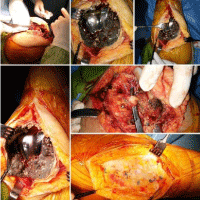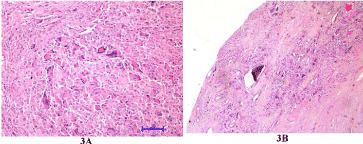
Case Report
Ann Surg Perioper Care. 2018; 3(1): 1037.
Metallosis: A Complication of Arthroplasties
Gunduz FK1, Ozturk B1, Atik A2 and Altun E3*
1Balikesir University, Faculty of Medicine, Balikesir, Turkey
2Balikesir University, Faculty of Medicine, Orthopedics and Traumatology Department, Balikesir, Turkey
3Balikesir University, Faculty of Medicine, Medical Pathology Department, Balikesir, Turkey
*Corresponding author: Eren Altun, Balikesirn University, Faculty of Medicine, Department of Medical Pathology, Balikesir, Turkey
Received: April 05, 2018; Accepted: May 03, 2018; Published: May 10, 2018
Abstract
Metallosis is a well-defined complication that may occur after artroplasties. Metallic biomaterials are used for disfunctional bone and joint tissues for a long time. Type of metal, its physical and chemical characteristics affect to tissue adaptation. These are the most convenient materials for skeleton-muscle system surgeries and used often. Metallosis is a result corrosion that occurs at joint because of protheses. In this text, three cases which are found metallosis between the years of 2016-2017 are discussed and presented in literature accompaniment.
Keywords: Artroplasties; Metallic Biomaterials; Metallosis; Gonarthrosis
Introduction
Stainless steels that are first inurement, cobalt-chromium alloys, titanium alloys, alumina, zirconia and some porous ceramics, silicon, polyethylene, polyurethane, polypropylene and polymethyl methacrylate are often used for orthopedic surgeries [1]. The stability of metallic biomaterials is higher than others, however these materials may react with body liquids differently and cause metallosis. Metallosis is an infiltration with metallic debris surrounding tissue of prothese, after then conversion to granulation tissue with macrophages and giant cells [2]. Metallosis is a well-defined complication that may occur after artroplasties [3]. Typical symptoms are presented as pain, swelling and deformity. High activity level of person is a factor that decreases the life of prostheses and this factor leads up to metallosis [4]. Metallosis has to be diagnosed early and its treatment has to start to prevent the bone destruction. Revision surgery is essential for the treatment.
Case Presentation
Case 1
A woman 81-year-old who had a bilateral total knee artroplasty 17 years ago, consulted our clinic with complaints as pain on both of knees and incapability to walk. The total revision arthroplasty was applied to the left knee. Intense metallosis tissues and pseudomembran were seen. Pseudomembran was excised expansively and metallosis tissues were debrided. These were sent to pathology laboratory. In macroscopic examination, one surface of operation material is dark green irregular-looking, relatively smooth; another surface of it relatively paries, that between 0.5-1 cm thickness, with adipose tissue. When these surfaces were compounded, the material reached 12.5 x 10 x 4 cm measures. Samples were taken from green and villous parts of the material (Figure 1). In microscopic examination, polyetylene-like-particle were in sight in the excision material under the polarize light (Figure 2A and 2B). Metallosis diagnosis was given the case with present indication.

Figure 1: Intraoperatif multiple images from patients.
Case 2
A partial hip acetabular revision was applied to a woman 63-year-old who had a left hip arthroplasty and was diagnosed coxarthrosis and hip contusion. The material was sent to pathology laboratory. In macroscopic examination, it had 7x4, 5x1 cm measures when it united and gray-green papillary on it. In microscopic evaluation, particle like structures and foreign body type granulomatous reaction was seen (Figure 3A and 3B). Metallosis diagnosis was given the case with present findings.
Case 3
A man 70-year-old appealed our clinic with pain at him knees and difficulty in walking. He said that his pains continued long since, attended not only daytime but also nights; he went up and down the ladder and crouched down difficultly. Grade 4 gonarthrosis was seen in right knee on x-ray images of the patient who didn’t have rheumatic story. The revision arthroplasty was applied to his right knee. The osteophytes that seen were cleaned and sent the pathology laboratory. Macroscopically, it was an irregular, a little concave operation material which had two parts, green-yellow areas and 5 x 4 x 3 cm measures. The histopathology of curretage material, foreign body type inflamatory granulation tissue which contained focused necrose fields was viewed. Metallosis diagnosis was given this case with present findings.

Figure 2: In microscopic examination, polyetylene-like-particle was in sight in
the excision material under the polarize light.

Figure 3: In microscopic evaluation, particle like structures and foreign body
type granulomatous reaction was seen.
Discussion
Metallic complications borned of orthopedic implants have been concerning in clinics for years [5]. Depending on the use of implants, potential side effects may occur such as local, bacteriologic, immunologic, neoplastic; furthermore bone resorption, metallosis and mechanical jamming of surrounding soft tissue [5].
The metallosis cases following knee and hip arthroplasties have already mentioned in the literature. However, metallosis is a rarely seen complication after total joint arthroplasties [6]. Carpal tunnel syndrome and metallosis correlation, acute carpal tunnel syndrome secondarily metallosis has been passed in the literature [7,8]. Metallosis is generally seen metal-on-metal protheses, however not only metal-on-metal, but also non-metal protheses [9].
Metallosis may cause local pain, instability and pigmentation in tissue with metallic debris [9] and be associated with systemically neurologic complications such as visual, auditory, cognitive problems, cardiac failure and hypothyroidism [9]. Systemic effects occur due to elevated serum metal ion concantrates [10,11]. There are the registrations about heart transplantation because of Co and Cr toxicity following the hip arthroplasty [12]. Elevated metal ions have teratogenetic and carcinogenic potential, however direct relation has not been proven yet [13]. Clinically, total blood metal ion levels are used for guess to abrasion and response of the tissue [14]. Nevertheless there is not a direct correlation between pathologic alteration and serum metal ion levels [15].
Histopathologically, diffuse granulamatous inflammation, wide lenfatic spread, small brown-black granules with histiocytes, T-cell rich lenfatic infiltration were seen [7]. Also, metallic particles that migrated from problematical joint tissue to dermis may pigmentation in skin. Foreign body reactions may occur with the implant volume that exceed the capacity of surrounding soft tissue [17,18].
Radiologically, radio dense lines called “bubble sign”, “cloud sign” and “metal-line” are diagnostic [9]. Computed tomography (CT) and Magnetic Resonance Imaging (MRI) might be used for metallic debris in surrounding tissues [1]. Revision surgery and debridement are necessary for the treatment [1].
High activity levels of person a factor that shortens the life time of protheses and precipitate metallosis [4]. Other factors may be metallurgical inability, production and sterilization, type of implanting, wrong sequences, compression or friction between implants and bones, micro motions [1].
Conclusion
Metallosis should be diagnosed early to prevent bone absorbtions. The results are rejoicing because of early diagnosis. In diagnosis, follow and prognosis, elevated serum metal ion levels are clinically significant.
References
- Özkurt B, Tabak AY. Metalik biyomateryaller ve metallozis. TOTBID Dergisi. 2011; 10: 83-86.
- Khan H, Hurworth M, Kop A. Metallosis following a dual coat porous hydroxyapatite shoulder hemiarthroplasty. Journal of Orthopaedics. 2015; 12: 266-271.
- Vivegananthan V, Shah R, Karuppiah AS, Karuppiah SV. Metallosis in a total knee arthroplasty. BMJ Case Rep. 2014; 2014.
- Birkett N, El-Daly I, Ibraheim H, Mbubaegbu C. Metallosis following full thickness wear in total hiparthroplasty. Journal of Surgical Case Reports. 2015; 2015: rjv122.
- Yang CC, Tang CL, Tzeng CY, et al. Metallosis after traumatic loosening of Bryan cervical disc arthroplasty: a case report and literature review. European Spine Journal. 2017: 1-6.
- Klontz KC, Smith WI, Jonathan CK. Acute Metallosis Following Total Knee Replacement – A Case Report. Journal of Orthopaedic Case Reports. 2014; 4: 21-23.
- Gavin J. Heyes, Harriet S. Julian, Ian Mawhinney. Metallosis and carpal tunnel syndrome following total wrist arthroplasty. Journal of Hand Surgery. 2017; 43.
- CS Day, AH Lee, I Ahmed. Acute carpal tunnel secondary to metallosis after total wrist arthroplasty. Journal of Hand Surgery. 2013; 38: 80-81.
- Catarina A, et al. Metallosis: A diagnosis not only in patients with metal-on-metal prostheses Oliveira. European Journal of Radiology Open. 2015; 2: 3-6.
- Jayasekera N, Gouk C, Patel A, Eyres K. Apparent Skin Discoloration about the Knee Joint: A Rare Sequela of Metallosis after Total Knee Replacement. Case Reports in Orthopedics. 2015; 2015: 891904.
- Babis GC, Stavropoulos NA, Sasalos G, Ochsenkuehn-Petropoulou M, Megas P. Metallosis and elevated serum levels of tantalum following failed revision hip arthroplasty - A case report. Acta Orthopaedica. 2014; 85: 677-680.
- Moniz S, Hodgkinson S, Yates P. Cardiac transplant due to metal toxicity associated with hip arthroplasty. Arthroplasty Today. 2017; 3: 151-153.
- Del Rio J, Beguiristain J, Duart J. Metal levels in corrosion of spinal implants. European Spine Journal. 2007; 16: 1055-1061.
- Lehtovirta L, Reito A, Parkkinen J, Hothi H, Henckel J, Hart A, et al. Analysis of bearing wear, whole blood and synovial fluid metal ion concentrations and histopathological findings in patients with failed ASR hip resurfacings. BMC Musculoskelet Disord. 2017; 18: 523.
- Grammatopoulos G, Munemoto M, Pollalis A, Athanasou NA. Correlation of serum metal ion levels with pathological changes of ARMD in failed metal-on-metal-hip-resurfacing arthroplasties. Archives of Orthopaedic and Trauma Surgery. 2017; 137: 1129-1137.
- Thomas S, Gouk C, Jayasakeera N, Freeman M. The Sequelae of Metallosis Resulting in Skin Pigmentation and Tattooing: A Case Presentation and Literature Review. The Surgery Journal. 2016; 2: e143-e146.
- Givissis PK, Stavridis SI, Papagelopoulos PJ, Antonarakos PD, Christodoulou AG. Delayed Foreign-body Reaction to Absorbable Implants in Metacarpal Fracture Treatment. Clinical Orthopaedics and Related Research. 2010; 468: 3377-3383.
- Wolff M, Haasper C, Zahar A, et al. Severe Metallosis and Elevated Chromium in Serum Following Implantation of the Joint Unloading Implant System. Arch Orthop Trauma Surg. 2017; 137: 1751-1754.